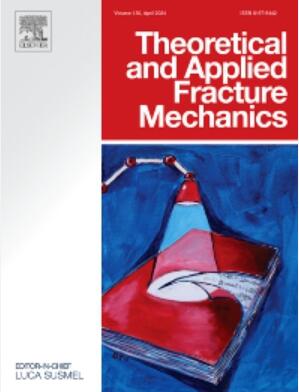Study on the characteristics of CO2 fracturing rock damage based on fractal theory
IF 5
2区 工程技术
Q1 ENGINEERING, MECHANICAL
引用次数: 0
Abstract
CO2 fracturing is emerging as a carbon–neutral technology for underground excavation. Traditional studies on structural stability during excavation have largely focused on the vibration characteristics of rocks. However, the inherent damage in rock layers during CO2 fracturing poses significant challenges for understanding damage mechanisms under complex multi-field coupling. This study introduces a novel approach for calculating rock damage induced by CO2 fracturing.We developed a physical model of CO2 fracturing and applied a “two-stage effect” division method, creating a staged damage calculation model based on fractal damage mechanics theory. Experiments were conducted under combined dynamic and static loads to evaluate rock damage. A two-factor Analysis of Variance (ANOVA) was used to assess the significance of dynamic and static effects on the extent of rock damage.The findings revealed that static loads guide crack propagation direction, reducing the angle between the crack and vertical axis, while initial CO2 dynamic load pressure strongly influences crack patterns, with higher pressures resulting in more fractures. The extent of rock damage observed ranged from 0.680 to 0.845. Although dynamic loads showed no significant impact, static loads exhibited a notable effect, as indicated by a P-value approaching 0.01. This study’s fractal-damage calculation model provides a valuable tool for addressing stability concerns in structures affected by CO2 fracturing.
基于分形理论的二氧化碳压裂岩石损伤特征研究
二氧化碳压裂技术正在成为一种碳中和的地下挖掘技术。对挖掘过程中结构稳定性的传统研究主要集中在岩石的振动特性上。然而,二氧化碳压裂过程中岩层的固有损伤对理解复杂多场耦合下的损伤机制提出了巨大挑战。我们建立了二氧化碳压裂物理模型,并应用 "两阶段效应 "划分方法,创建了基于分形损伤力学理论的分阶段损伤计算模型。我们在动态和静态综合载荷下进行了实验,以评估岩石损伤情况。研究结果表明,静载荷引导裂缝扩展方向,减小裂缝与垂直轴之间的夹角,而二氧化碳初始动载荷压力对裂缝形态有很大影响,压力越大,裂缝越多。观察到的岩石破坏程度从 0.680 到 0.845 不等。虽然动态载荷没有明显影响,但静态载荷却有显著影响,P 值接近 0.01。这项研究的分形破坏计算模型为解决受二氧化碳压裂影响的结构的稳定性问题提供了一个宝贵的工具。
本文章由计算机程序翻译,如有差异,请以英文原文为准。
求助全文
约1分钟内获得全文
求助全文
来源期刊

Theoretical and Applied Fracture Mechanics
工程技术-工程:机械
CiteScore
8.40
自引率
18.90%
发文量
435
审稿时长
37 days
期刊介绍:
Theoretical and Applied Fracture Mechanics'' aims & scopes have been re-designed to cover both the theoretical, applied, and numerical aspects associated with those cracking related phenomena taking place, at a micro-, meso-, and macroscopic level, in materials/components/structures of any kind.
The journal aims to cover the cracking/mechanical behaviour of materials/components/structures in those situations involving both time-independent and time-dependent system of external forces/moments (such as, for instance, quasi-static, impulsive, impact, blasting, creep, contact, and fatigue loading). Since, under the above circumstances, the mechanical behaviour of cracked materials/components/structures is also affected by the environmental conditions, the journal would consider also those theoretical/experimental research works investigating the effect of external variables such as, for instance, the effect of corrosive environments as well as of high/low-temperature.
 求助内容:
求助内容: 应助结果提醒方式:
应助结果提醒方式:


